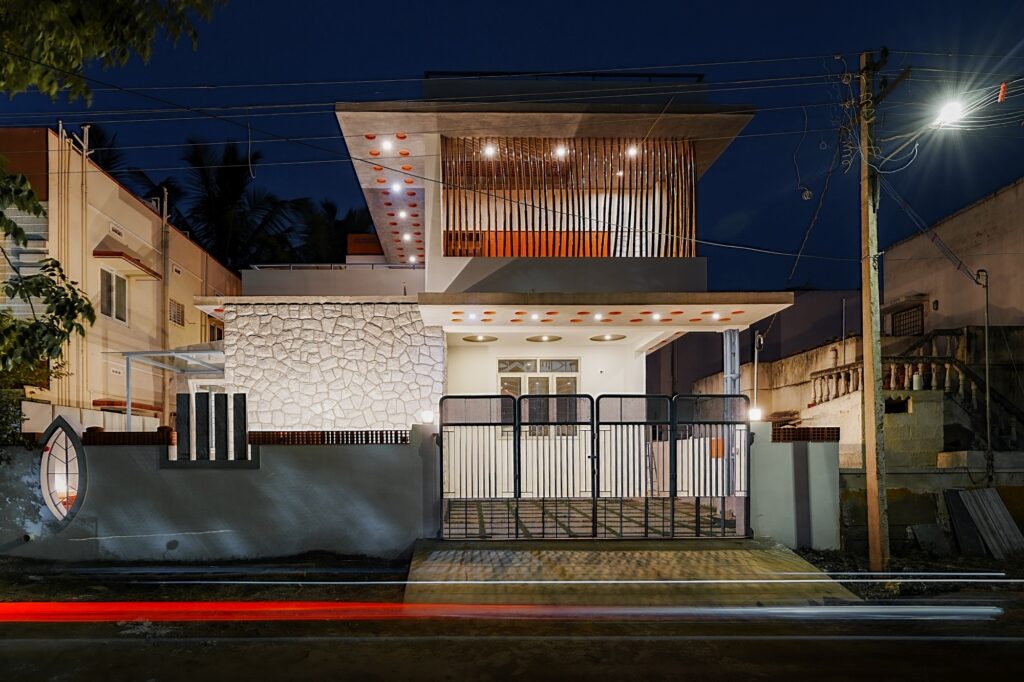
The project “ இயலிடம்”-The place of belonging revolved around a idea that the villa we are designing has to create a lingering sense of belonging.
The context of the site is such that it is located in an area which was once a coconut grove with a lot of peacocks which in future evolved into suburbs. The microclimatic study suggested that the plot receives a good amount of wind from the north east quadrant and the western quadrant. The plot abuts a couple of villas on the north and south. The road width is 30 feet, and the plot opposite the site is another villa that verticals at a height of 20 feet, so technically the site is facing the west and had a good amount of northwest and southwestern harsh light entering the house in one-fourth of the day.


Planning
Framing all these factors we programmed a space planning such that the western part of the design comprises open, semi-open and semi-public spaces like a buffer zone beside that we planned the semi-private spaces, and at the end, we had the utility areas. The second thought we had was to use bio filtering option to diffuse light & reduce the western heat and also to create a cushion against the bedroom spaces. another aspect is such that we were inspired by the subtleness of the context of the site with which we ought to play around.



The entry will animate us through the walkway to the main door. Through the main door, we enter inside the foyer and living space which changed the dimension from rigid to angular geometry and the access to the other spaces was designed at a different floor level from the sunken living portion to create a sense of delight while going through the spaces. Once we level up to the semi-enclosed dining area it combines itself with the stairwell of the house which enlightens the spaces throughout the day. The dining area looks out to the greenery on the periphery which vertically and visually connects the bedrooms at the upper tier.
The house is incorporated with the idea of “thinnai” – a structure used in the heritage homes of India for congregation and trade in front of the dwellings. Inbuilt concrete seating called thinnai were created all along the villa to instill the idea of leisure talking and social gatherings that we pace faster in our millennial lives.



Elements and Materials
The house is designed in terms of its volume to create the venturi effect and stack out the hot air. Curvilinear fillets were created at the corners and junctions to use the space effectively and to create an even dispersion of light. The villa is majorly done with plastered surfaces and encompassed the usage of porotherm walls in the area of harsh heat conduction. The filler slabs with pots, hurudles and concrete rings were used to create the dynamics of the design. The main load-bearing column outside the building is done with steel pipes to conceal the conventional concrete jungle. The foyer is designed with the RR masonry which creates a dramatic entry to the veranda. The flooring is done with the polished Kota stones which is a good thermal effective material. The grill patterns were done to abstract the coconut leaves in the context and have secret signage of the design elements used inside the house. The thinnai were capped with the jaisalmer stones.
The villa gives an ambiguity to the clients in their own way.





A rain watching area was created with a concrete diwan to enjoy the small wonders of the locality from where one can witness the peacocks dancing in rain.
The curves and asymmetrical spines were inspired from the peacocks around the villa.
Project Features
1)Climate Responsive Planning
2)Passive lighting
3)Stack effects used with the volume
4)Contextual Acoustics
5)Thermal Efficiency
6) Carbon-negative Possibilities
7)Fillerslab
8)Concrete ring slabs
9)Rainwater harvesting
10)Usage of thinnai (concrete seating)
11)Grills were designed along the context
12)Levels were used
13)permanent stack ventilators done
14)curvilinear volumes
15)Porotherm were used
16)Kota natural stones were used.
17)Stone masonry incorporated
18)lighter MS columns done
19)exposed concrete was used
20)amalgamation of curved, rigid and angular geometry
Gallery
Project Details
Completion Year: 2023
Gross Built Area (m2/ ft2): 3450
Project Location: Vadavalli, Coimbatore
Program / Use / Building Function: Residential architecture
Photo Credits: Robin Shibu rs






















3 Responses
very interesting details and use of terracotta
So quit keeping it in your reference
God bless to your team.
Thankyou sir !! I worked under Ar. Prathima Seethur madam only !!!…